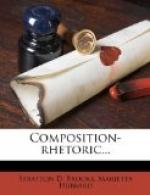See, how the lightning flashes!
+11. Rules for the Use of the Dash.+—1. The dash is used to show sudden changes in thought or breaks in speech.
I can speak of this better when temptation comes my way—if it ever does.
2. The dash is often used in the place of commas or marks of parenthesis to set off parenthetical expressions.
In the mountains of New York State this most valuable tree—the spruce— abounds.
3. The dash, either alone or in connection with the comma, is used to point out that part of a sentence on which special stress is to be placed.
I saw unpruned fruit trees, broken fences, and farm implements, rusting in the rain—all evidences of wasted time.
4. The dash is sometimes used with the colon before long quotations, before an enumeration of things, or before a formally introduced statement.
+12. Rules for the Use of Quotation Marks.+—1. Quotation marks are used to inclose direct quotations.
“In all the great affairs of life one must run some risk,” she remarked.
2. A quotation within a quotation is usually indicated by single quotation marks.
“Can you tell me where I can find ’Rienzi’s Address’?” asked a young lady of a clerk in Brooklyn.
3. When a quotation is interrupted by parenthetical expressions, the different parts of the quotation should be inclosed in quotation marks.
“Bring forth,” cried the monarch, “the vessels of gold.”
4. When the quotation consists of several paragraphs, the quotation marks are placed at the beginning of each paragraph and at the close of the last one.
+13. Rule for the Use of the Apostrophe.+—The apostrophe is used to denote the possessive case, to indicate the omission of letters, and to form the plural of signs, figures, and letters.
In the teacher’s copy book you will find several fancy A’s and 3’s which can’t be distinguished from engravings.
II. REVIEW OF GRAMMAR
THE SENTENCE
+14. English grammar+ is the study of the forms of English words and their relationship to one another as they appear in sentences. A sentence is a group of words that expresses a complete thought.
+15. Elements of a Sentence.+—The elements of a sentence, as regards the office that they perform, are the subject and the predicate. The subject is that about which something is asserted, and the predicate is that which asserts something about the subject.
Some predicates may consist of a single word or word-group, able in itself to complete a sentence: [The thrush sings. The thrush has been singing]. Some require a following word or words: [William struck John (object complement, or object). Edward became king (attribute complement). The people made Edward king (objective complement)].




